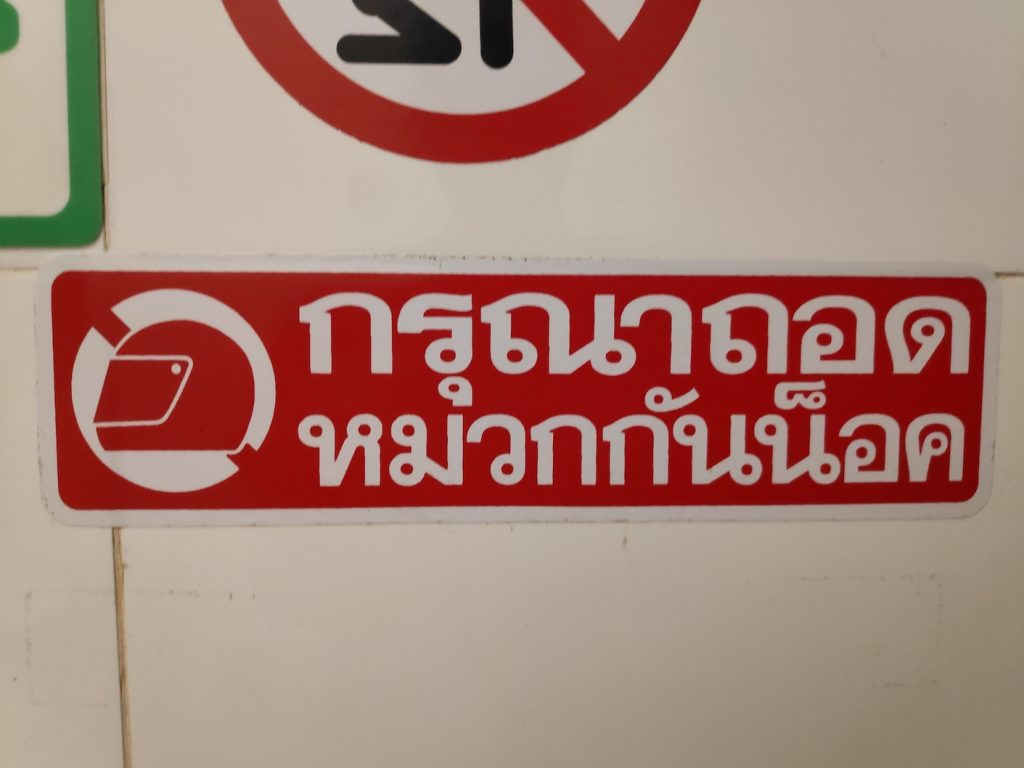One of the first things you’ll want to know how to say in Thai is how to say please. First off, nobody ever uses ได้โปรด (dai-prod) or กรุณา (karuna) and neither should you. These are very formal and not used in regular conversation. They are primarily used in signs and public announcements. If you are reading this post, you are probably not making Thai signs or doing announcements at the airpot so you don’t ever need to say these. We have to mention this because Google thinks this is how you say “please” in Thai.
It’s important to note that, Thai people don’t say please and thank you at the same rate or in all the same situations as you might in English. In a many situations, instead of actually saying “thank you,” you just say the polite gender particle (khrap ครับ if you are male + ka ค่ะ if female) which can mean a lot of things depending on context.
*Transliteration for Thai is awful. If you want to ever be able to speak Thai well, you absolutely need to learn the script. As intimidating as it may look, it’s just a bunch of symbols which represent sounds and you can learn it all in 10 or 20 hours. Is it worth a little time to save yourself potentially years of frustration both in being understood, and understanding people? YES, of course it is.
How to say “Please give me (something)” in Thai
Pattern: ขอ (SOMETHING) หน่อย (kɔ̌ɔ SOMETHING nɔ̀ɔi)
If you want someone to give/hand/pass you something:
-
ขอ (something)
หน่อย (kɔ̌ɔ something nɔ̀ɔi).
- ขอแก้วหน่อย (kɔ̌ɔ gɛ̂ɛo nɔ̀ɔi) – please give me a glass / pass me the glass
-
ขอตังค์หน่อย (kɔ̌ɔ dtang nɔ̀ɔi) – please give (me some) money
- *Thai is a very contextual language so if everyone in earshot knows that I am asking you for money, there is no need to say “I” or “You.”
*Note that when ordering food/drink or something at a store, it’s perfectly acceptable to just use เอา (ao). In these sentences, the gender particles kind of functions like “please.”
- เอา + SOMETHING ครับ/ ค่ะ (ao something kráp kâ) – I’ll have SOMETHING / I’ll take SOMETHING / Give me SOMETHING
How to say “Please VERB for me” in Thai
You can use the same pattern to ask someone to do a VERB (or verb phrase) for you by replacing the object above with a VERB. In this case, we usually drop the ขอ (khaw) as the หน่อย already functions as please. When you are asking someone to do a VERB for you, you’ll usually want to add the word ให้ (hâi) after it. ให้ (hâi) means “to give” and when you VERB+GIVE in Thai, it means you are doing the VERB for someone or asking someone to do the VERB for you.
- เปิดให้หน่อย – (bpə̀ət hâi nɔ̀ɔi) please open for me
- ช่วยเปิดให้หน่อย (chûai bpə̀ət hâi nɔ̀ɔi) help open (this) for me
- เปิดให้หน่อยได้มั้ย (bpə̀ət hâi nɔ̀ɔi dâi mái) can you please open for me?
Which one is best? If you are a beginner, I’d recommend starting with the shortest, easiest one. It’s already polite enough as the หน่อย (nɔ̀ɔi) is already functioning like “please.” Once you can say that one confidently, learn another longer variation.
VERB + ให้หน่อย (hai noi) – Please do VERB for me
These sentences can be used when asking someone to perform an action for you.
- เขียนให้หน่อย (kǐan hâi nɔ̀ɔi) Please write (something) for me.
- ทำให้หน่อย(tam hâi nɔ̀ɔi) Please do (something) for me.
- ซื้อให้หน่อย (sʉ́ʉ hâi nɔ̀ɔi) Please buy (it) for me.
- เช็คให้หน่อย (chék hâi nɔ̀ɔi) Please check (it) for me.
- ดูให้หน่อย (duu hâi nɔ̀ɔi) Pleae look (at it) for me.
How to Make Polite Requests in Thai
Here’s a few additional example sentences when requesting things from people in Thai if you want to be extra polite.
- ช่วยหน่อยได้มั้ย + ครับ/ ค่ะ (chûai nɔ̀ɔi dâi mái + kráp/ka) – Can you please help me?
- ขอยืมปากกาหน่อยได้มั้ย + ครับ/ ค่ะ (kɔ̌ɔ yʉʉm bpàak-gaa nɔ̀ɔi dâi mái + kráp/ka) – Can I please borrow (a/your) pen?
It’s also possible to place the word “help” ช่วย (chûai) at the beginning of a sentence when making a polite request in Thai. We tend to add the particles หน่อย (nɔ̀ɔi) or ด้วย (dûai) at the end of phrases like this.
- ช่วยถอดรองเท้าด้วย (chûai tɔ̀ɔt rɔɔng táao dûai) Please take off your shoes.
- ช่วยเปิดขวดนี้ให้ด้วย (chûai bpə̀ət kùat níi hâi dûai) Please open this bottle (for me)
- ช่วยเอานี้ใส่ถุงให้หน่อย (chûai ao níi sài tʉ̌ng hâi nɔ̀ɔi) Please put this in a bag (for me)
Polite Written Requests in Thai
These are examples you may find on signs or possibly in public announcements, but never in actual conversation.
- กรุณาถอดรองเท้า (gà-rú-naa tɔ̀ɔt rɔɔng táao) – Please take off your shoes.
- กรุณาอย่ารบกวน (gà-rú-naa yàa róp guan) – Please do not disturb.
- กรุณาถอดหมวกกันน็อก (gà-rú-naa tɔ̀ɔt mùak gan nɔ́k) – Please remove helmet (SIGN below)
Learn Thai Language Program
Want to learn to speak Thai? Our online Thai program contains a series of courses that teach you all the core skills you need to start speaking and reading Thai. Try some free lessons from the foundation course and see for yourself how well it works.



